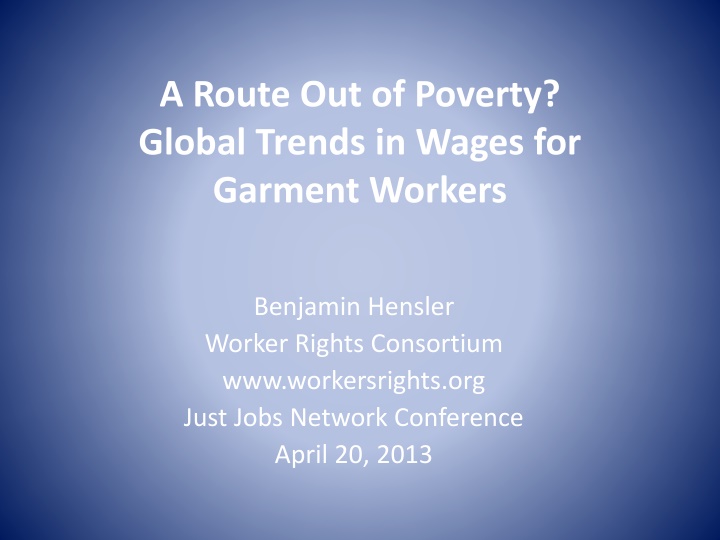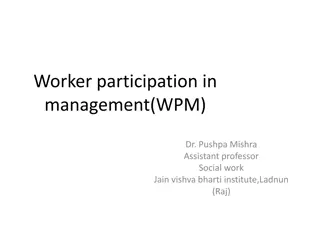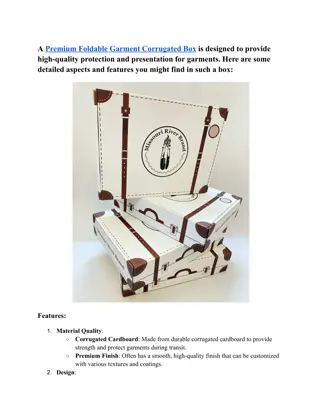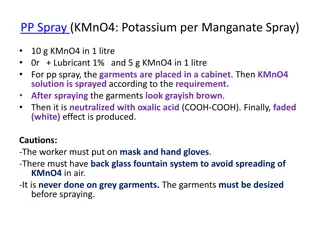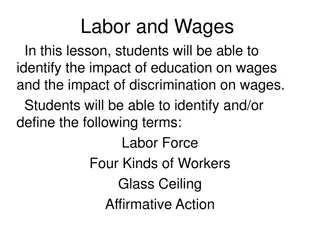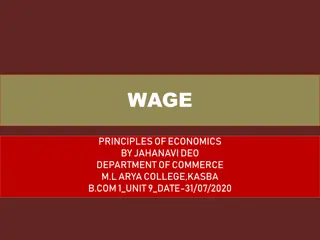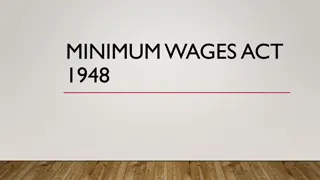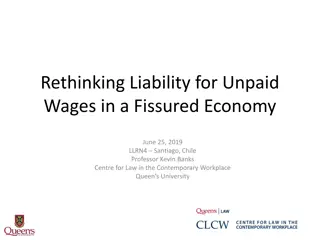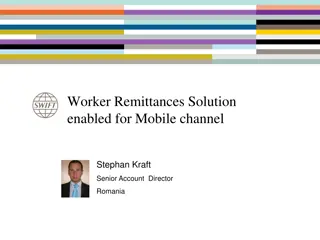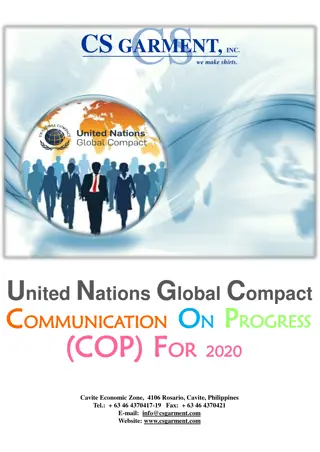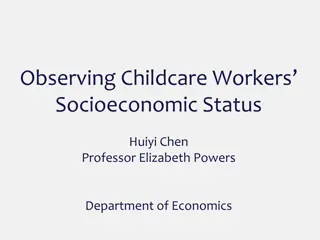Global Trends in Garment Worker Wages: A Closer Look
Explore the dichotomy of garment workers' wages in the global industry, analyzing the race to the bottom versus the potential route out of poverty. Worker Rights Consortium's research sheds light on real wage trends and challenges faced by garment workers in leading exporting countries.
Download Presentation

Please find below an Image/Link to download the presentation.
The content on the website is provided AS IS for your information and personal use only. It may not be sold, licensed, or shared on other websites without obtaining consent from the author.If you encounter any issues during the download, it is possible that the publisher has removed the file from their server.
You are allowed to download the files provided on this website for personal or commercial use, subject to the condition that they are used lawfully. All files are the property of their respective owners.
The content on the website is provided AS IS for your information and personal use only. It may not be sold, licensed, or shared on other websites without obtaining consent from the author.
E N D
Presentation Transcript
A Route Out of Poverty? Global Trends in Wages for Garment Workers Benjamin Hensler Worker Rights Consortium www.workersrights.org Just Jobs Network Conference April 20, 2013
Worker Rights Consortium Independent nonprofit garment factory monitoring organization founded in 2000. Primary focus: monitoring factories producing apparel for brands like Nike, Adidas, etc., under license from universities in USA, Canada, UK. WRC has 180 university and college affiliates including leading institutions such as Harvard, Princeton, Stanford, University of California, etc. Conducts factory monitoring in 15 leading garment exporting countries in Latin America and Asia, including India and Bangladesh.
Garment Workers and Globalization: Two Views The global garment industry is engaged in a race to the bottom. Working conditions are often harsh and rights violations are common. Price pressure on factories and countries from international buyers keeps wages low.
Garment Workers and Globalization: Two Views Garment manufacturing is a route out of poverty. Garment factories expand low-skill formal employment. Garment work is more secure and offers higher incomes than informal and agricultural work
Questions Studied Is there a race to the bottom in garment industry wages? Are garment factories providing a route out of poverty ?
Is there a race to the bottom in garment industry wages? WRC examined real wage trends in 15 leading garment exporting countries: 15 of top 21 countries in 2011 in garment exports to USA (9 of top 10), 80% of US garment imports. Researched prevailing straight-time wages for garment workers in each country in 2001 and in 2011. Adjusted 2011 wage figures for intervening inflation. Measured increase (or decrease) in inflation-adjusted wages between 2001 and 2011.
Percent Change in Real Wages between 2001 and 2011 140.00% 120.00% 100.00% 80.00% 60.00% 40.00% 20.00% 0.00% -20.00% -40.00%
In More Than Half of the Countries Studied Real Wages Fell In 5 of the top 10 exporters: In Bangladesh, Mexico, Honduras, Cambodia and El Salvador wages declined by an average of 15% between 2001 and 2011. In 9 out of 15 countries studied: The above, plus the Dominican Republic, Guatemala, Philippines and Thailand. Wages there fell by a per country average of 12.4%.
Only 4 Countries Saw Significant Real Wage Gains for Garment Workers from 2001 to 2011: Real wages rose substantially in Indonesia, Vietnam and Haiti 42% on average. Real wages more than doubled in China 124% increase. Real wages rose, but very modestly, in India (12%) and Peru (17%) over this 10 year period.
Are garment factories providing a route out of poverty ? WRC compared prevailing wages for garment workers in apparel-exporting countries to a living wage for garment workers in each country: Estimated living wage figures in 2001 and 2011 for each country included in study. Calculated, for each country, the share of a living wage provided by the prevailing wage for garment workers. Where real wages had risen, calculated the rate of convergence between prevailing and living wage.
What Is a Living Wage? A Living Wage is: One that provides a basic, but decent, life style that is considered acceptable by society at its current level of economic development . . . [such that] [w]orkers and their families [are] able to live above the poverty level, and . . . participate in social and cultural life. The Right to a Living Wage Is: [A] mainstream idea with a long and distinguished pedigree recognized in UN UDHR (1948) and ILO Declaration on MNEs (2006). (Anker, ILO: 2011)
Estimating Living Wages Preferred method is a market-basket study in a single locale (Anker, ILO: 2011). Market-basket-derived living wage has been implemented and tested since 2010 in a Dominican Republic factory (Kline, 2012). Dominican living wage figure was converted for other countries in study for 2001 and 2011 using World Bank PPP factors and CPI data. Same conversion method used by the only MNE to implement a global living wage (Novartis, AG).
The Living Wage Gap Prevailing wages for garment workers in 2001 on average, provided barely more than one- third (35.7%) of a living wage. In 2011, the comparable average figure stood nearly unchanged (36.8%). In the lowest wage countries, prevailing wages provided less than one-fifth of a living wage: Bangladesh 14% in 2001, and 2011. Cambodia 24% in 2001, 19% in 2011.
Prevailing Wage as a Percentage of Living Wage 100% 90% 80% Prevailing Wage as a Percentage of Living Wage 70% 60% 50% 40% 2001 30% 2011 20% 10% 0% Country
Where the Wage Gap Widened The gap widened In countries where real wages fell both lower wage and higher-wage countries. In particular, the gap grew in countries where prevailing wages in 2001 provided a relatively greater share of a living wage: Guatemala (57% of living wage in 2001, 50% in 2011), Honduras (52% of living wage in 2001, 47% in 2011).
Even Where Real Wages Rose the Wage Gap Still Remained Large In countries where real wages rose significantly from 2001 to 2011, prevailing wages remained far below a living wage: China (prevailing wage provided 36% of a living wage in 2011), Indonesia (22% of a living wage), Vietnam (29% of a living wage), Haiti (24% of a living wage).
Years to Convergence of Prevailing Wage and Living Wage 50 45 40 35 30 Years 25 20 15 10 5 0 China Vietnam Haiti Peru Indonesia Country
Looking Ahead In more than one half of the countries studied, if 2001-2011 trends continue, the living wage gap will continue to widen. In nearly all countries where real wages rose, even if same levels of wage growth are maintained, gap will persist for several decades more (35-45 years in Indonesia, Vietnam, Haiti). Only in China, and only if recent levels of real wage growth are sustained, will the living wage gap be closed in the next ten years.
Are garment factories providing a route out of poverty ? It depends Rates of absolute poverty ($1/day PPP or national threshold) are generally lower for apparel workers than agricultural or service workers (World Bank, 2012). But Prevailing straight-time wages for garment workers continue to provide only a third of a living wage. Except in China, the gap between prevailing wage and living wage hardly narrowed from 2001 to 2011.
Some Observations Export apparel manufacturing expands formal sector employment, but by itself does not directly produce many jobs that pay a living wage. The fastest-growing apparel-exporter today, Bangladesh, is the country which has most consistently pursued a low-wage strategy. Factory monitoring alone may not increase wages the country whose factories were monitored by the ILO during this period, Cambodia, saw wages fall by a greater degree than in neighboring countries.
Some Observations But other low-wage countries China, Indonesia, Vietnam, and Haiti were able to significantly increase wages. Wage policies matter countries with significant real wage growth aggressively increased the legal minimum wage. But sustained growth requires international buyers and manufacturers to absorb greater labor costs and moderate threats of exit.
The Worker Rights Consortium thanks the Center for American Progress and the Just Jobs Network for their support and collaboration. www.workersrights.org
Questions on Methodology - Countries Not Included in Study Which of the top apparel exporting countries were not included in the study and why? Pakistan, Sri Lanka, Nicaragua, Italy, Egypt, Jordan. These are countries where WRC does not regularly conduct research on factory conditions.
Questions on Methodology - Definition of Prevailing Wage How did you define prevailing wages ? Generally, as total monthly wages, excluding premium pay for overtime and production bonuses and in-kind compensation, but with the addition of the pro-rata monthly value of other compensation received during year by law or industry practice (annual bonuses, etc.).
Questions on Methodology - Estimating Prevailing Wages How did you estimate a prevailing wage in each country that was included? Where available, we used published data on average straight-time wages in the export garment sector. Where published data was unavailable, we: Generally researched wages in each country s largest center of export apparel production. Focused on wages for workers in the largest job classification for which data was available. Consulted with local labor experts (academics, NGOs, trade unions).
Questions on Methodology Overtime Compensation Why didn t you include overtime compensation in prevailing wages? Variability due to seasonality and business cycles in importing countries. Increased compensation from overtime reflects additional time and labor, not just a higher rate of compensation. Overtime hours and payments often violate national laws and buyer standards. Overtime compensation is typically not considered when measuring prevailing wages vs. living wages (ILO, 2011). Reliance on overtime is negatively associated with quality of employment for workers and countries (World Bank, 2011).
Questions on Methodology Production Bonuses Why didn t you include production bonuses in prevailing wages? Generally, local experts consulted by WRC indicated that production bonuses were not available without overtime work that is often otherwise uncompensated. For this reason, we generally treated production bonuses as equivalent to overtime compensation, - which also was not included in prevailing wages. Where our research indicated this was not the case, we included them.
Questions on Methodology In-kind Compensation Why didn t you include in-kind compensation (food, transport, housing, etc.) in prevailing wages? Variability in quality makes it difficult to estimate market value of employer-provided goods and services. Often benefits employers as much as workers; and/or only benefits some groups of workers. In-kind compensation is negatively associated with quality of employment (World Bank, 2011).
Questions on Methodology Estimating a Living Wage How did you estimate a living wage ? In 2008 and 2010, we conducted market-basket studies in the Dominican Republic. We included specific costs of locally appropriate items in recognized expenditure categories in quantities sufficient for a family of average size. Resulting wage figure was at midpoint of existing cost- of-living estimates by central bank and trade unions. Living wage implemented at factory where workers consumption patterns have been studied by public health experts since 2010.
Questions on Methodology Converting Living Wages Transnationally How did you use the Dominican Republic living wage figure to estimate living wages for the other countries? We used World Bank PPP conversion factors and CPI data to arrive at living wage estimate for 2001 and 2011 for the other countries (same method used by Novartis).
Converting Living Wages Transnationally What are the methodological issues with using the Dominican Republic living wage figure to estimate living wages for the other countries? Variability in expenditure patterns and cost of living across and within countries (Anker, ILO: 2011); Variability in average family size and number of wage earners across and within countries.
Questions on Methodology Estimating Prevailing Wage for India We focused on Bangalore where garment manufacturers generally are larger (Gokuldas, Shahi, etc.) and wage practices more transparent than in NCR and Tamil Nadu. We researched wages for the largest group of non-piece rate employees - approximately the lower-paid one- third of the workforce.
Questions on Methodology Estimating Prevailing Wage for India We included the industry, city and job-specific minimum wage, plus VDA (COLA), and pro- rata monthly value of the annual bonus. We estimated prevailing monthly straight-time wages of Rs. 2019. 55 in 2001 and Rs. 4,422.17 in 2011. Deflated for 2001-2011 CPI (+94%), the value of the 2011 wage in 2001 Rs. was Rs. 2,281.27, yielding an increase in real wages of 12.6%.
Questions on Methodology Estimating a Living Wage for India We estimated a living wage in Dominican Republic of 6789 pesos (US$ 401) per month in 2001 and 21, 237 pesos (US$555) per month in 2011. Using World Bank PPP Conversion Factors, we estimated living wages in India of Rs. 10,043 (US$ 212) per month in 2001 and Rs. 19,468 (US$ 417) in 2012. India 2011 living wage figure in US$ is somewhat higher than those for Bangladesh, Cambodia and Vietnam, and significantly lower than those for China, Indonesia and Thailand.
